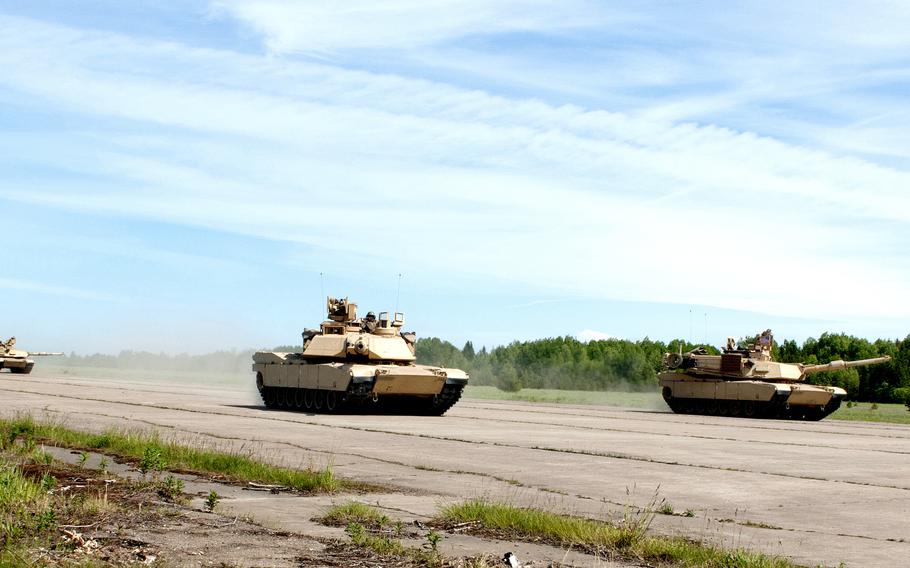
Soldiers with 1st Armored Brigade Combat Team, 3rd Infantry Division conduct tank maneuver training in 2015, in Estonia. The war in Ukraine has shown that the way tank formations maneuver needs to be rethought, 1st Armored Division commander Maj. Gen. Curtis Taylor said. (Juana M. Nesbitt/U.S. Army)
WIESBADEN, Germany — A recent robotic assault by Ukraine on Russian positions north of Kharkiv marked a watershed moment for how ground combat forces must prepare for war, a top U.S. general said this week.
The attack saw 50 Ukrainian unmanned ground vehicles and aerial drones seize initial positions. It pushed the Russians back and paved the way for Ukrainian troops to hold the territory.
“I think that battle right there indicates that the time to reimagine armor has begun, and we have got to think about what armor will look like in the future,” 1st Armored Division commander Maj. Gen. Curtis Taylor said Thursday.
For tank units, that means thinking about protecting formations with a layered defense, similar to the way a naval aircraft carrier group maneuvers at sea.
“We need to think of a combined arms battalion more like a carrier strike group that has embedded countermeasures,” Taylor said.
Taylor and other top Army commanders discussed how the Russia-Ukraine war has upended traditional ground warfare tactics at the Association of the U.S. Army’s two-day symposium in Wiesbaden.
Defense industry leaders showcased systems for NATO militaries, while commanders stressed the need for faster innovation.
Much of the discussion revolved around how drones have transformed the modern battlefield. The shift affects everything from coordinating assaults to supplying troops and managing the stress of being under constant surveillance.
“To counter (unmanned aerial systems), it can quickly burden small unit leaders,” said Col. Donald Neal, commander of the Vilseck, Germany-based 2nd Cavalry Regiment.
Ground troops are working with a wide range of systems to monitor the skies, which means keeping track of large amounts of unsynchronized data. Managing that data needs to be part of combat arms training, Neal said.
“What’s hard is to get all these systems to talk to each other … getting all the data to be centrally processed and pop up on a common operating picture so you can see the things flying in the air,” he said.
Meanwhile, the practice of convoying supplies to troops at the front lines is becoming obsolete because of the ubiquitous presence of camera-equipped drones.
“We usually have these large clusters of formations. We like to drive in convoys,” said Maj. Gen. Ronald R. Ragin, commander of the 21st Theater Sustainment Command. “I do not believe that that will be applicable on future battlefields, because if you can be seen, you can be killed.”
The situation also puts pre-positioned weapons stocks at risk, he said. Large NATO warehouses would be immediate targets.
In Ukraine, “I can tell you that ammunition depots were targeted,” Ragin said. “Any fixed facility that can be found was targeted, and it was eliminated on both sides.”
The Army is working with allies to set up discreet, dispersed locations across NATO’s eastern flank and in Northern Europe, he said.
“Matter of fact, some of them are in Estonia, some of them Lithuania, a lot in Poland and then across the theater, so we’ve got to be dispersed,” Ragin said.
Given the high costs of such arrangements, the Army is looking to allies to spend more, he added.
For NATO, there is urgency to boost weapons production.
U.S. European Command’s Gen. Alexus G. Grynkewich, speaking Thursday in Wiesbaden, said allies must prepare for the possibility of a two-front war with Russia and China in the coming years.
“We’re going to need every bit of kit and equipment and munitions that we can in order to beat that,” said Grynkewich, NATO’s supreme allied commander.
In Ukraine, more than 70% of combat vehicle losses since January have been caused by small drone strikes, Taylor said.
It’s now cheaper and easier to take out targets than it is to protect them, he said.
“You see this all the time, with $900 drones destroying $9 million combat systems,” Taylor said. “We’ve got to change that cost calculus if we’re going to be able to operate on the future battlefield.”
Stars and Stripes reporter Phillip Walter Wellman contributed to this report.